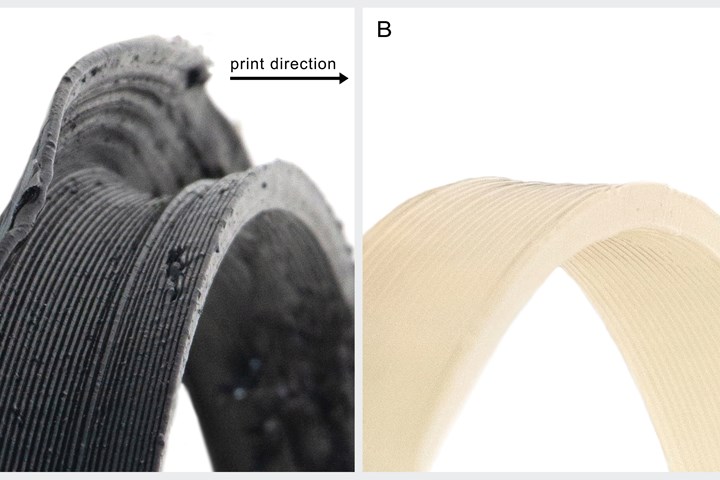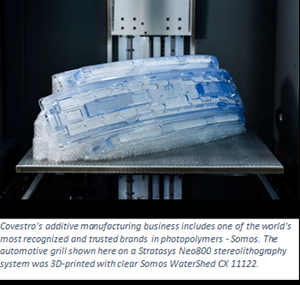PLA for Large-Format Additive Manufacturing
NatureWorks’ new Ingeo 3D700 shown to provide significant reduction in warping, minimizing print failures.
A PLA biopolymer specially designed for large format additive manufacturing that boasts a significant reduction in warping that minimizes print failures is newly available from NatureWorks, Minnetonka, Minn. Moreover,Ingeo 3D700 has been evaluated by multiple global ‘industry partners’ for use in large-format fused filament fabrication (FFF) in the form of a monofilament, and direct resin-to-print processes in the form of resin pellets with positive results. This has included a shrink rate less than 0.25% in printed parts and obtainable lower print temperatures due to optimized melt viscosity and microstructure.
In large-format printing, the higher rate and volume of polymer deposition can quickly result in excessive warpage with materials such as ABS, or significant shrinkage as with some polyolefins or even some general-purpose PLA grades. This can result in failed prints as warping pulls the part away from the print bed or causes layer separation. With the longer print times and higher-volume material use in industrial applications, failure during production is costly. By controlling the polymer-microstructure, the resulting amorphous PLA grade, Ingeo 3D700, has a low material shrink rate which is critical for reducing warpage, improving gap fill and adhesion, and ensuring successful prints.

Notable warping with PP. left. New Ingeo grade for the same part on right.
Said NatureWorks’ business development leader Dan Sawyer, “As the 3D printing space expands into larger, more complex applications, we are seeing an increased need for printing materials that are tailored for a specific application or process. With significant growth in large-format additive manufacturing for industrial applications, we saw the opportunity to develop a new Ingeo biopolymer grade specifically designed to minimize the loss of time and material due to failures in large format prints.”
A common approach for minimizing part warpage in large prints is to use compounded materials with reinforcement such as mineral fillers, glass, carbon, or cellulosic fiber. Because Ingeo 3D700 has been designed for low shrinkage, there is an opportunity to use less reinforcing product and still achieve quality large-format parts, while maintaining the reliable printability of Ingeo PLA. If a specialty print requires additional reinforcement, then cellulose-based additives are easily compounded with Ingeo 3D700 creating a biobased compound alternative to high-cost petrochemical-based compounds such as carbon-fiber ABS.
Said Xiaofan Luo, president at Polymaker, a leading manufacturer of 3D printing material and filament, “In our testing, we found that Ingeo 3D700 goes one step further towards reducing warpage in large-format prints beyond previous Ingeo PLA grades designed for 3D printing.” In addition to lower shrinkage, Polymaker also measured improved z-layer adhesion when printing with Ingeo 3D700.
Dyze Design, an extruder designer and supplier of components for large-format printers, ran print tests comparing Ingeo 3D850, a grade already known for its low-shrink characteristics, and new Ingeo 3D700. Said Dyze CTO Philippe Carrier, “Our tests showed that a large-format part printed using Ingeo 3D850 demonstrated a shrink rate of 1.25%. In comparison, the same part printed with Ingeo 3D700 had a shrink rate of less than 0.25%. Because Ingeo 3D700 also has a higher throughput rate, we were able to successfully print at the lower temperature of 190 C (374 F) without seeing shrinkage or warping in the part.”
Filament manufacturer MCPP conducted printing tests using filament made from Ingeo 3D700 and demonstrated a 11-13% increase in flow rate due to the optimized melt viscosity, compared to a general-purpose PLA. According to MCPP, “this resulted in improved gap fill and adhesion between perimeter layers. Therefore, it is also expected to be suitable for FGF (fused granular fabrication) 3D printing.”
The new Ingeo 3D700 grade is already finding use in metal casting manufacturing. Using a direct resin-to-print process, Shanghai TuoZhuo is printing sand casting molds that can be as tall as 1-2 meters. The 3D printed molds are replacing traditional wood foundry molds because they are faster to produce, more cost efficient, and easier to maintain as wood molds warp over time due to moisture. Said Gabino Chen, project manager at Shanghai TuoZhuo New Materials Technology Co., Ltd. “There is no warping or deformation when printing with an amorphous PLA grade like Ingeo 3D700. Using ABS, PETG, or PA in prints of this size is difficult, which is why it’s important to use PLA and useful to have a PLA grade specifically designed for large format printing.”
Related Content
Low-Smoke, Non-Halogen Polyolefinic Compound for Armored Cables
Avient’s latest addition to its ECCOH portfolio is designed to prevent environmental stress cracking in low- and medium-voltage cable sheathing.
Read MoreStratasys to Acquire Covestro’s Additive Manufacturing Materials Business
This acquisition will result in Stratasys having an expanded portfolio of differentiated materials in stereolithography, DLP, and powders.
Read MoreNOVA’s BOPE-HD Film Resin Gains in Globally Available Flexible Food Packaging Applications
Positioned as a recyclable packaging alternative to traditional BOPET films, BOPE-HD film is now available from companies such as Inteplast, JK Materials, Oben Group, and Polivouga.
Read MoreAutomation in Thermoforming on the Rise
Equipment suppliers’ latest innovations exemplify this trend driven by factors such as labor shortages, higher-speed thermoformers and tighter quality control.
Read MoreRead Next
Beyond Prototypes: 8 Ways the Plastics Industry Is Using 3D Printing
Plastics processors are finding applications for 3D printing around the plant and across the supply chain. Here are 8 examples to look for at NPE2024.
Read MoreMaking the Circular Economy a Reality
Driven by brand owner demands and new worldwide legislation, the entire supply chain is working toward the shift to circularity, with some evidence the circular economy has already begun.
Read More























